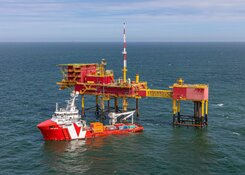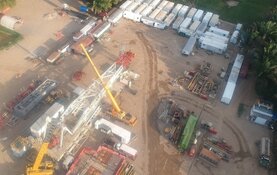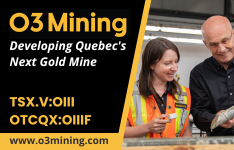Chris Mayer: It came to me when I considered how other people were looking at the changes that were going on around the world. The consensus seemed to be that it was a new thing that China and India joining the world market, for example, and that this was creating something very different. The point I wanted to make in the book is that what is happening is more normal when you look at the broader sweep of markets. The anomaly has been the dominance of the West, which we've seen in the last 100 years or so.
One of the statistics I love to talk about and mention in the book comes from another book called, "Power and Plenty: Trade, War, and the World Economy" written by professors Ronald Findlay and Kevin H. O'Rourke. They show how in 1953, the Western world represented 90% of the world's manufacturing output. Think about that. That is a remarkable dominance by a relatively small part of the world's population. Since that time, of course, it's gone more in reverse. As I write in my book, 2008 was the first year when global gross domestic product was roughly 50% from developed markets and 50% from developing markets. The book's title is meant to imply how we're returning to a much more normal situation when you look at it from the longer, historical point of view.
TER: Where is the opportunity for investors in the "World Right Side Up" scenario?
"There will still be plenty of opportunities in the West, and some of them will only emerge because of what's happening abroad."
CM: There are a lot of opportunities, but I would say they come from these other markets catching up to the Western world. For example, in the book, one of the excerpts I use is from a guy named Robert Chaplain, who was a foreign correspondent for many years. He talked about how when Japan had its post-war boom, sales of washing machines went up something like fourfold from 1953 to 1955 and then doubled again in 1956. You could see a similar pattern happen with things like refrigerators and televisions. That kind of pattern we see happening now in a lot of other markets around the world. The opportunities come from consumers looking more like Western consumers. You'll see convergence of a lot of prices within all kinds of industries. The book goes country by country, looking at different opportunities from energy to agriculture and all across the spectrum.
TER: The developed economies are beginning to show some weakness. Do they have the depth to remain stable while the economic center of gravity shifts to the global East and South?
CM: No, I don't think so. I expect things in both developed economies and developing economies will be very unstable. There will be a lot of confusion and false trends, a lot of fits and starts. But I wouldn't write off the developed economies. They still have the primary advantage of lots of capital, and they tend to be more transparent. This thesis is not a negative development for the West. There will still be plenty of opportunities in the West, and some of them will only emerge because of what's happening abroad.
TER: Are you saying that the investment opportunities arise in the instability of the relationships?
CM: Yes, some of the opportunities will be a direct result of instabilities in those relationships. Some new opportunities will come about only because of things that are going on overseas. For example, you could argue that the energy boom we're having in North America was only brought about because the growth in China, India and these other markets started to drive up the cost of energy, which then drove the need for innovation and new sources of supply. The world economy is a web; things that happen in what seem like faraway places affect us here, and they are tied together in complicated ways.
TER: In your book, "Invest Like a Dealmaker," you highlight the advantages of investing with inside knowledge of market operations. What counts as inside knowledge? How can retail investors gain the insider's perspective?
CM: I use the phrase broadly in the book, and I don't mean insider knowledge in the illegal sense. What I mean by insider knowledge is watching what insiders do and appreciating the dynamics that go on behind the scenes: how companies are put together, how they're financed, how they're controlled. These are things that don't show up on a stock screen when you're looking for price/earnings ratios or some other easily observed metric.
There are plenty of examples. I love investing in spinoffs. There is a long history of spinoffs outperforming the market because they have their own dynamic as to why pricing tends to be good there. One of the companies I recommended last year is called Rouse Properties Inc. (RSE:NYSE), which was spun out of General Growth Properties Inc. (GGP:NYSE). This was a company where one of the large insiders, Brookfield Asset Management, essentially had an agreement in place where it was offering to buy a bunch of stock at $15/share, even though the stock was trading then at $10/share. That's something that wouldn't show up on the screen if somebody was looking for a low price/earnings stock, a low price/book stock or yield. But it spoke to the value that was in that business. Ultimately, Rouse Properties wound up being $17–18/share a year later.
Another example would be insider buying. That's another great signal I'm often watching for. When you see an insider or group of insiders buy a significant amount of stock, that's a signal you should probably take a look. This gets to one of the things I talk about most: I encourage investors to look at the control groups behind the business. By control groups, I mean look at who is calling the shots. Sometimes it's the CEO. Sometimes it's the chairman. Sometimes it might be an investor group that owns a lot of stock. And understand what their goals are for the business. There is plenty of research that backs up the idea that owner-operated firms, where the insiders own a lot of stock, outperform their peers. They tend to make better decisions about how they allocate their capital, and they tend to do value-unlocking activities. They tend to engage in things like spinoffs. They buy back stock when it's cheap. These are the kinds of things I'm looking for.
TER: To identify the insiders and the other indicators that lead you to good investments, you have to follow a particular company pretty closely. How do you identify the companies that you want to follow?
"You have to enjoy studying businesses. I like to follow these businesses. I like to see how they change and grow over time."
CM: It comes from being in the business for a while. You don't start off, of course, with a big list. You start off with a short list, and you build it over time. I would say you can start by focusing on those firms where insiders own a good percentage of the stock. Draw a line, say, 10%, 15% or 20%. Start with industries you know and are more comfortable with. Then pay attention, again, to those insider buys. Those at least will give you some timely names to look at. You have to enjoy studying businesses, I think. I like to follow these businesses. I like to follow their stories and see how they change and grow over time. I always tell my readers there's no rush to invest; be patient. It sometimes takes months and months to find a company you like, but part of the fun is the hunt.
TER: You identify dealmakers as "people who think about stocks as whole companies, as things with real assets and cash flows that exist in the real world." How would an investor who is used to focusing more narrowly on stock prices, quarterly reports and financial leading indicators learn to adopt a dealmaker's perspective?
CM: You have to start with the idea that the market price you see is just one price. That price is not necessarily the best price. When you look up a quote on Yahoo! Finance or E*TRADE or whatever, it reflects all kinds of things that don't have anything to do with the value of the business over the long haul. If you adopt that mindset, then you don't panic when prices go down and you don't get overly excited when prices go up. You have to develop a separate benchmark to value a business.
I look at two things. Think about replacement cost. For example, Covanta Holding Corp. (CVA:NYSE; CVGYQ:OTCBB) is a company that turns waste into energy. It has a certain amount of output. You can figure out how much it costs to build so many tons of capacity. Then you come up with a number. Right now, I think $300,000 per ton of capacity is a pretty good number. When you figure all that out, Covanta is worth at least $30/share if you were to trying to rebuild those assets from scratch. That's replacement cost. That has nothing to do with what is going on in the stock market. Whether the stock is $20/share one day or $25 the next month or whatever, you have this anchor. You have this deeper understanding of what those assets are, what the value of them is and what it costs to reproduce them. That's one good metric.
Another strategy I like to use is to think about private market value. Think about what it would cost a strategic buyer to buy the whole company. This isn't easy to figure out either, but that's why these things are valuable. For example, with bank stocks, there are plenty of transactions in banks. You look and you can see these banks stocks are being bought at 1.2 times book value, 1.4 times book value, and let's say you find a pretty good bank at 80% of book value. Then that's an example of a business that's significantly cheaper in the market than it is to a private acquirer.
What I do is try to find as many of these disparities as I can in whatever industry they may happen to be in. But it's not for people who want to look at stock charts and who want to trade a lot. This is more for people who want to buy a stock and a business, they want to understand it and they want to hold on to it for a few years and earn a very good, long-term return.
TER: You cover an interesting mix of industries, including seismic data, oilfield services and agriculture. How do your investment principles help you find the investment value in these diverse companies?
CM: The industries change, but the elements that make for a great investment never change. I look at four essential elements, and I have an acronym for them: CODE.
'C' stands for cheap. I want to buy undervalued securities. I measure that primarily by replacement cost and private market value.
The 'O' is for owner-operators. I want to invest in companies in which the insiders own a significant percentage of the stock. I want them to have skin in the game.
The 'D' is for disclosures. I want to invest in businesses that are transparent, businesses that I can understand.
'E' is for excellent finances. I want to invest in companies with very strong financial conditions, companies that don't have a lot of debt and do have a lot of cash.
I find these four elements combined make a good, winning formula. I simply apply these to a wide variety of fields. I've always been a generalist, and have gone wherever the opportunities are versus someone who is very focused on one specific industry. I'd rather trade off a little of that depth for perspective.
TER: Can you give me some examples of companies that you are actually covering that you are applying these principles to?
CM: I like Pulse Seismic Inc. (PSD:TSX; PLSDF:OTCQX). The company is headquartered in Calgary. It owns a seismic library that covers key areas of western Canada, mainly in Alberta. Oil and gas companies have to decide where to drill. How they decide is by shooting seismic, which gives them an idea of what is below. Pulse Seismic leases out the use of its seismic maps to oil and gas companies. What's great about this company is that once you shoot a seismic library, you can use it again and again. It's a profitable business that generates a tremendous amount of cash. Another thing I like about Pulse is the owners. Here, the owners own about 17% of the stock, and they have been good allocators of capital. Last year, they bought back about $10 million of stock. The company pays an $0.08 annual dividend. It has used some of its cash to reduce debt.
C-O-D-E
- Cheap
- replacement costs indicate undervalued securities
- Owner Operators
- insiders have skin in the game
- Disclosures
- business is transparent
- Excellent Finances
- cash rich, debt free
Pulse Seismic has grown nicely. I recommended it when it was $1.89/share. It's about $4.25/share today, and I still think it's a very good buy. I think it could easily be worth $5/share. It has the ownership group. It's a transparent business. When you look at the cash flow of the business, it's simple. It has a great balance sheet, and the stock is cheap. Last year it probably did about $0.80/share in free cash flow. For a stock that's $3.60 today, you're paying a very low multiple for the cash flow. It's also leveraged to natural gas. Natural gas is cheap right now, and if eventually natural gas prices go up, drilling activity will increase, and Pulse Seismic is in a good position for that. There are a lot of different ways to win with this company.
Another example I like from the energy space would be CanElson Drilling Inc. (CDI:TSX.V). The strength of CanElson is the ownership group, which started a couple other drilling companies with a lot of success. Elson McDougald is the current chairman. He founded a company called Tetonka Drilling Inc. in 1997, which was bought out in 2000. During his three-year run, investors had an annual return of 30%. He also founded, along with CanElson President/CEO Randy Hawkings and Director Donald Seaman, a firm called Western Lakota Energy Services Inc., which was bought out in 2006. In a six-year run there, investors earned a return of over 80%.
CanElson Drilling is the group's third gig. They wanted to build a company that has a very flexible rig fleet, something that crews could maintain and repair on site. They run a very low-cost operation. They call themselves the Southwest Airlines of the oil and gas drilling industry. That manifests itself in a number of different ways. You can see it in the cost per rig for the company to build, which could be anywhere from 15–50% cheaper than its competitors can build. You can see it in its higher return on invested capital. And you can see it in the higher utilization of its rig fleet. It's very well managed. The insiders here own around 10% of the stock. The company has a good balance sheet. It's trading fairly cheaply. The earnings last year were about $0.58/share. That was up 29% from 2011. It pays a $0.05/quarter dividend, which it boosted to $0.06/share. At $5.40/share, the yield is almost 5%. CanElson is a pretty good deal.
TER: Back to Pulse Seismic for a minute. It had high front-end costs connected with gathering geologic data long before it could sell maps. What was the point at which you realized it was time to invest in Pulse?
CM: When I recommended Pulse, it was trading for around 5 times cash flow. When you collect a portfolio of companies trading at that ratio, I would suggest that you're not going to lose very often.
With Pulse, you pointed out something important: the earnings power of the business is a little obscured because of the accounting treatment of its seismic surveys. The company pretty clearly explains it in its presentations and does a good job of walking shareholders through how it all works. If you focus on the cash flow/share at Pulse, you'll see that it is very high. For me, Pulse came on my radar because it was very cheap on a cash-flow basis. Then as I went through these other hurdles, it cemented that. Pulse Seismic is probably one of the best businesses I've ever encountered as an analyst. Think about owning an asset that you pay for one time. You mentioned its up-front costs of gathering the seismic data. But once you have it, you can use it again and again and again. The company still has surveys going back to the 1980s that it is earning good cash on. It has surveys that it acquired in 2000 and 2002 that it has gotten five times its money back on. It's a very good business.
TER: You also cover Alliance Grain Traders Inc. (AGT:TSX), which is agricultural. How does the fertilizer market play into your "World Right Side Up" strategy?
CM: The basic thesis is that the population is going to increase by a certain percentage, and one of the first things that changes when countries get richer is their diet: People start eating a richer, more complex diet. We know that that diet is much more grain-intensive. That's what led me to fertilizers early on. I started recommending fertilizer stocks in 2005. I've tried to find other ways to take advantage of some of the trends in agriculture because I think agriculture is going to be an important trend for a long time, especially in the context of this "World Right Side Up" idea.
Alliance Grain Traders is interesting because it processes pulses, which include crops like lentils, chickpeas and beans. These are high-protein foods that are more nutrient-rich than a lot of grains. They use a lot less water to grow. They are just starting to catch on more as a food ingredient. You're starting to see companies like pasta makers and cereal makers mix lentil or chickpea flour in with their regular wheat flour to create a more nutrient-rich food. I expect demand for pulse crops is going to continue to grow over time.
Alliance Grain Traders has spent the last decade building out a world-class network of assets. It has facilities in Turkey, which I visited earlier this year, Canada, South Africa and Australia, and it is building facilities in China and India. The company brings in a crop from a farm, washes it, cleans it, polishes it, sorts it, splits it, bags it and does all the other services in between that get the product to your table ready to use. As the demand for these crops increases, Alliance Grain Traders will get a cut of that business. It's had an up-and-down ride, but the stock, again, is pretty cheap. It trades right around book value. There is a big yield to it, close to 5%. I think about 25% of the stock is in the hands of the CEO, Murad Al-Katib. It has all the different elements that I look for: It's cheap, it has an owner-operator, it's a transparent business we can understand and it has a good balance sheet. I think Alliance Grain Traders is a great long-term holding.
TER: What do you hope that the attendees at the Agora Financial Investment Symposium later this month will take away from your speech?
CM: I hope, first of all, they come away with a few good ideas that make them some money and that they otherwise would never have found. That's one of the things I've become known for, digging up these lesser-known opportunities like a Pulse Seismic or a CanElson. Second, I hope that they learn a little something about the world they didn't know before. I travel a lot, and I've built up a great network of contacts around the world that have managed to shake out some great opportunities. I often find perspectives that you won't find in the mainstream from people who are writing about a place from very far away. I haven't prepared my presentation yet, but the theme of the conference, "A Tale of Two Americas," ties into what we're talking about here, which is that there are two Americas. There is one that will thrive in this new world, and there's another that will struggle. I have some ideas about what will do well.
TER: Can you elaborate on the two Americas?
CM: We talked about how a "right side up" world will bring a lot of changes and it's not going to be a stable or smooth process. Let's say you're a lean American manufacturer who can compete globally. You're going to have a lot of opportunities versus one that is involved in an older legacy business like steel, for example, where it's hard to compete with some of the overseas manufacturers. In my mind, there is always going to be a split. There are going to be companies and industries that succeed in this new world. I think American energy is going to be a big winner, for example. American agriculture is in a great position. There are others that are going to have to adjust or they are going to wither away. We've seen some of that already with some of the more traditional American manufacturers that struggled, although there is a revival of certain American manufacturers that's interesting. That's what I mean by two Americas. There is going to be a part of it that thrives. I wouldn't let doom-and-gloom perspectives about the U.S. government's fiscal situation and the like blind you from some of the compelling opportunities that are emerging here in the U.S. and in Canada.
TER: Do you have any parting thoughts to share?
CM: Sometimes these strategies are not focused on an industry, but on an idea. I tend to like the opportunistic firms where you have a big owner-operator who's entrepreneurial about how to run the business. A number of the companies that we follow in the Capital and Crisis newsletter tend to be companies that are focused on picking up opportunities in whatever sector. There have been times where you could buy companies that acquire hotels cheaply or companies that buy bank debt cheaply. These are areas that I'm focusing on, too. There are always interesting opportunities out there.
TER: Chris, this has been a fascinating interview. I appreciate your time.
Chris Mayer is managing editor of the Capital and Crisis and Mayer's Special Situations newsletters. He began his business career as a corporate banker. Mayer left the banking industry in 2004 after a 10-year career and signed on with Agora Financial. His book, "Invest Like a Dealmaker: Secrets from a Former Banking Insider," outlines his value investing approach. In April 2012, Chris released his newest book, "World Right Side Up: Investing Across Six Continents," which covers his extensive global travels and investment research.
Want to read more Energy Report interviews like this? Sign up for our free e-newsletter, and you'll learn when new articles have been published. To see a list of recent interviews with industry analysts and commentators, visit our Interviews page.
DISCLOSURE:
1) Tom Armistead conducted this interview for The Energy Report and provides services to The Energy Report as an independent contractor. He or his family own shares of the following companies mentioned in this interview: None.
2) The following companies mentioned in the interview are sponsors of The Energy Report: None. Streetwise Reports does not accept stock in exchange for its services or as sponsorship payment.
3) Chris Mayer: I or my family own shares of the following companies mentioned in this interview: None. I personally am or my family is paid by the following companies mentioned in this interview: None. My company has a financial relationship with the following companies mentioned in this interview: None. I was not paid by Streetwise Reports for participating in this interview. Comments and opinions expressed are my own comments and opinions. I had the opportunity to review the interview for accuracy as of the date of the interview and am responsible for the content of the interview.
4) Interviews are edited for clarity. Streetwise Reports does not make editorial comments or change experts' statements without their consent.
5) The interview does not constitute investment advice. Each reader is encouraged to consult with his or her individual financial professional and any action a reader takes as a result of information presented here is his or her own responsibility. By opening this page, each reader accepts and agrees to Streetwise Reports' terms of use and full legal disclaimer.
6) From time to time, Streetwise Reports LLC and its directors, officers, employees or members of their families, as well as persons interviewed for articles and interviews on the site, may have a long or short position in securities mentioned and may make purchases and/or sales of those securities in the open market or otherwise.









































